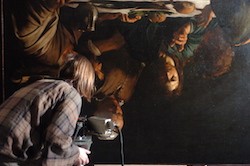Putting together the pieces of Europe’s cultural heritage puzzle
From prehistoric cave paintings to medieval churches, from Renaissance sculptures to modern graffiti – Europe’s cultural heritage is world-renowned. Yet despite its trove of cultural treasures, Europe’s reputation in heritage science is not at the same level. One reason for this is the fact that heritage science is often left to individual Member States. As such, each European country is focused on its own research, using its own state-of-the-art facilities and academic institutions. However, to ensure that Europe’s cultural heritage gets the attention it deserves, there needs to be a collaborative, European-wide approach to heritage science. The EU-funded IPERION CH (Integrated Platform for the European Research Infrastructure ON Cultural Heritage) project is working to integrate these national efforts and to connect experts from across Europe. “By opening up world-class facilities to a wider number of researchers and academics, we hope to foster more collaborative work and to strengthen Europe’s reputation in heritage science,” says Project Coordinator Luca Pezzati. The field of heritage science embraces a wide range of research disciplines, each of which supports the various aspects of tangible and intangible cultural heritage conservation, interpretation and management. A viable research community For example, if your research team is restoring a church in Italy, you might benefit from using specific analytical tools or the opportunity to consult with a similar restoration project. However, unless these tools and experience can be found in Italy, you probably won’t be able to access it. “A constant challenge for researchers in this field is that cultural heritage is so fragmented,” explains Pezzati. “The tools and information that a researcher might require are all too often dispersed in archives or institutions located across Europe.” For Pezzati and his colleagues, the answer to the challenge of fragmentation is infrastructure. “The IPERION CH infrastructure will provide access to all services, instruments and expertise from participating institutions via one central access point,” he says. “For us, it’s all about achieving better coordination among institutions and creating a viable research community for European heritage science.” Ready access Currently, IPERION CH is comprised of 23 partners from 12 Member States, along with one in the US. These partners include a range of leading cultural research centres, laboratories, museums and universities. Through one of the project’s three central platforms, heritage scientists can now readily access 19 leading facilities. For example, the MOLAB platform provides researchers with access to mobile laboratories. This allows them to perform their research in situ and not have to move fragile works of art or precious archaeological pieces to a laboratory – essential to ensuring the safety of the objects being examined. Other available platforms include FIXLAB, for large-scale facilities, and ARCHLAB, for archiving technical and scientific data. In addition to making better use of European knowledge and expertise, the IPERION CH project also aims to raise awareness about the social and economic importance of protecting our cultural heritage. “When it comes to funding programmes or research priorities, cultural heritage is rarely in the headlines,” says Pezzati. “One of the reasons we want to create this infrastructure is to raise the profile of this field.” An ongoing process Because of projects like IPERION CH, heritage science is beginning to be viewed at the same level as more traditional scientific disciplines. “Building up heritage science is a slow process, and this project is just one step towards our objective,” says Pezzati. Once complete, the IPERION CH research infrastructure will feed into the European Research Infrastructure for Heritage Science (E-RIHS). This ambitious infrastructure project, which is currently in its preparatory phase, aims to integrate cultural and natural heritage research, connecting researchers in the humanities and natural sciences and fostering a trans-disciplinary culture of exchange and cooperation.
Keywords
IPERION CH, cultural heritage, heritage science



